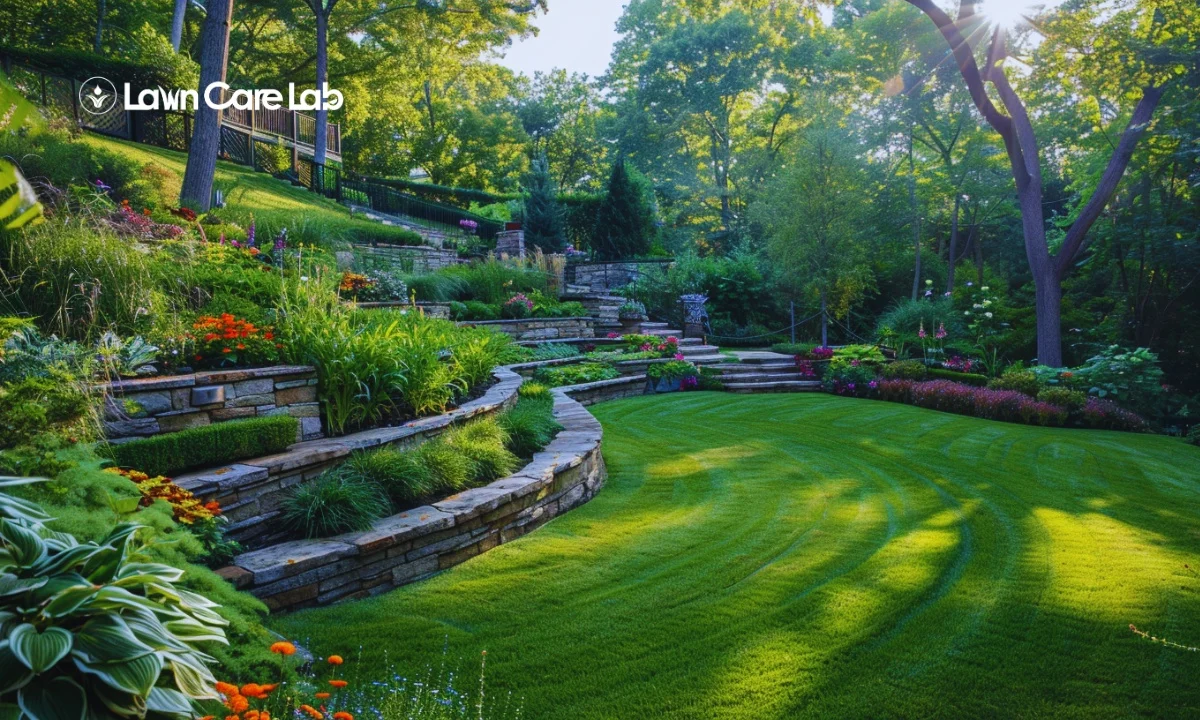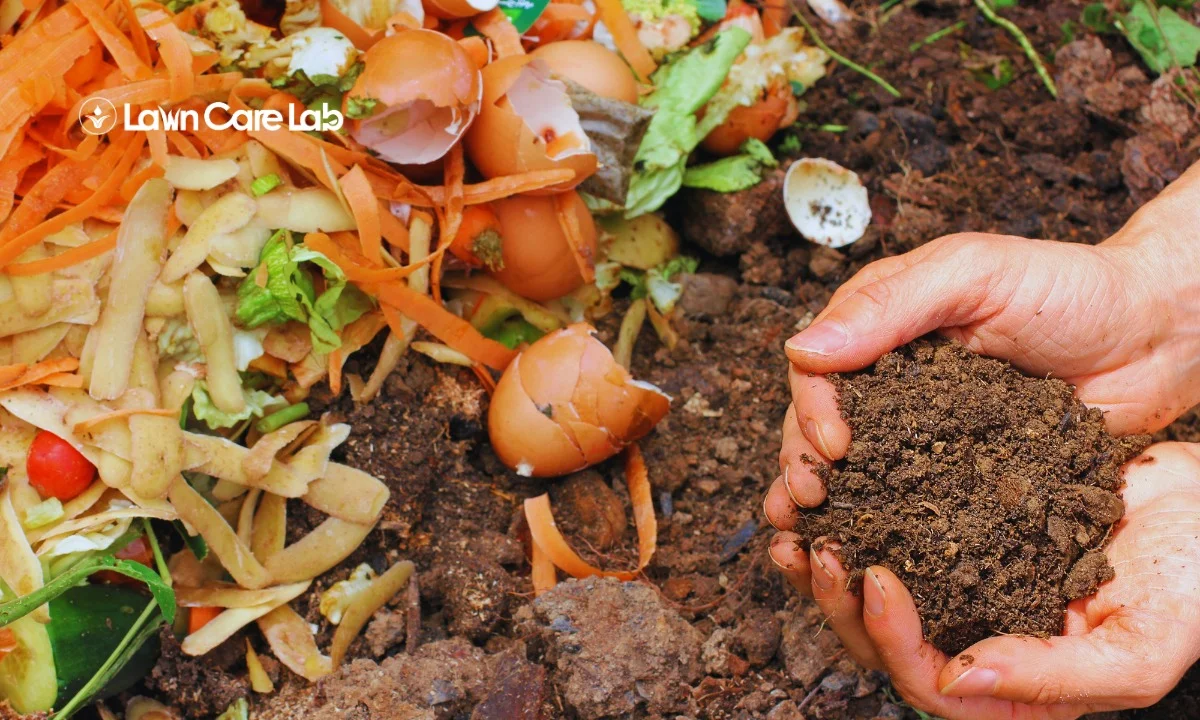Maintaining a sloped lawn presents unique challenges that differ significantly from those of a flat yard. Soil erosion, water runoff, and uneven growth are common issues that require specific strategies to address effectively.
Choosing the right plants, employing proper watering techniques, and implementing safe mowing practices are essential to maintaining a healthy and attractive sloped lawn. Additionally, incorporating elements like retaining walls and terracing can help stabilize the soil and enhance the landscape’s aesthetic appeal.
This guide will provide detailed strategies to help you manage and beautify your sloped lawn, ensuring it remains vibrant and secure.
Table of Contents
Introduction to Sloped Lawn Maintenance
Maintaining a sloped lawn is essential to prevent soil erosion and keep your yard healthy. Managing water runoff and stabilizing the soil can be challenging, but adequately watering, mowing, and planting techniques can effectively address these issues.
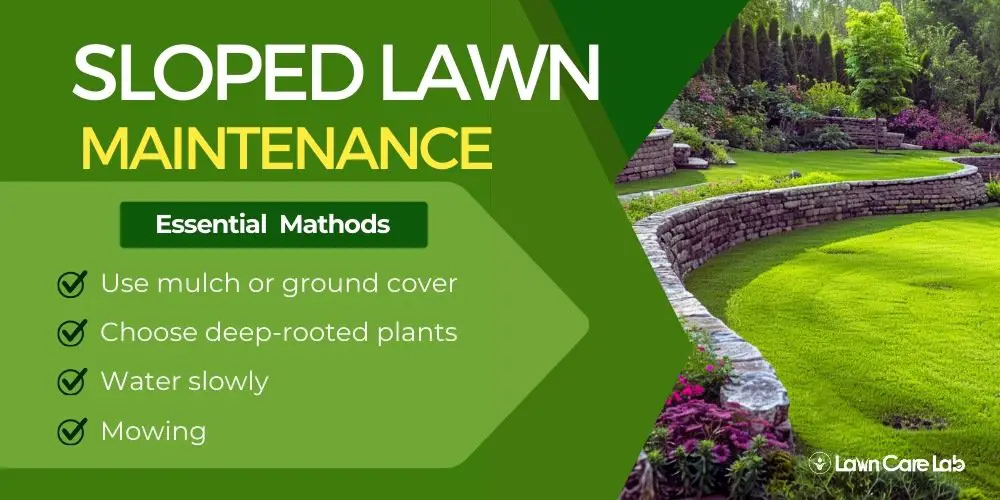
Use mulch or ground cover plants like creeping thyme to manage water runoff and prevent erosion. When mowing, cut the grass diagonally to reduce strain on the slope. Choose deep-rooted plants like fescue grass or shrubs to help stabilize the soil. Water slowly and evenly to allow absorption without washing away soil.
Caring for sloped lawns also preserves nutrient-rich topsoil and reduces the risk of barren patches and landslides. A well-maintained slope enhances property value, supports local biodiversity, and withstands extreme weather, reducing runoff and filtering pollutants.
Sloped lawns face unique challenges like water runoff, soil erosion, and uneven growth. Maintaining a healthy lawn requires careful landscaping, erosion control, and plant selection.
Soil Erosion Control
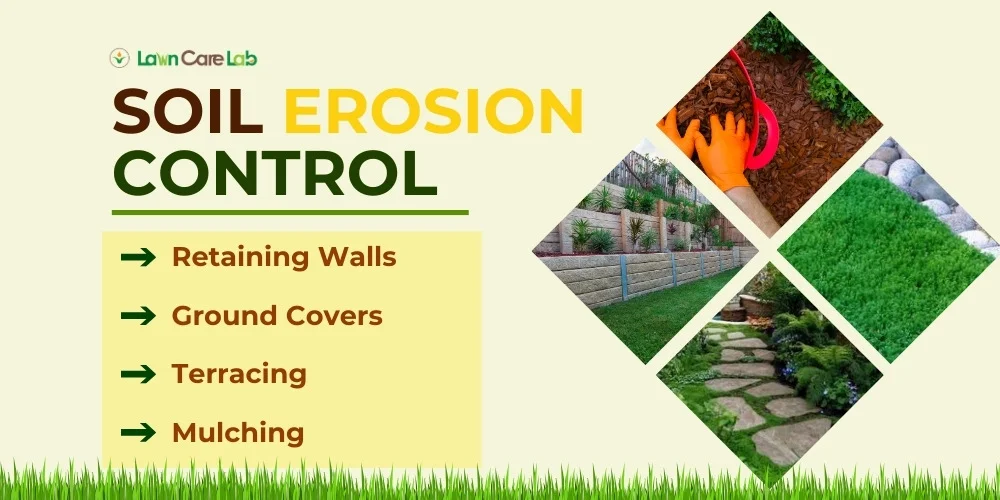
To control soil erosion on sloped lawns, a combination of effective techniques and proper materials are required. The key methods include installing retaining walls, planting ground covers, constructing terraces, and applying mulches, each offering specific benefits for soil stabilization, water management, and landscape enhancement.
| Technique | Description | Benefits | Example Materials/Plants |
| Retaining Walls | Installing walls using materials like stone, concrete, or timber to break up slopes and slow runoff | Stabilizes soil, reduces water runoff, and enhances landscape | Stone, Concrete, Timber |
| Ground Covers | Planting robust root plants such as creeping thyme, sedum, or periwinkle to anchor the soil | Anchors soil, requires minimal care, reduces weed growth, and enhances garden appearance | Creeping thyme, Sedum, Periwinkle |
| Terracing | Creating flat areas on slopes to break them into smaller, manageable sections | Reduces erosion, and Promotes sustainable landscaping | Custom terrace designs |
| Mulching | Applying organic (wood chips, straw, compost) or inorganic (gravel, stones) mulches | Protects soil and retains moisture. Adds nutrients (organic) | Reduces rain impact, Prevents runoff, stabilizes soil, and adds nutrients (organic) |
| Mulching Tips | Spread mulch 2-4 inches deep, refresh organic mulch regularly, and use netting on steep slopes | Reduces rain impact, Prevents runoff, stabilizes soil and adds nutrients (organic) | Scotts Nature Scapes Mulch, EZ-Straw Seeding Mulch |
Watering Techniques for Sloped Lawns
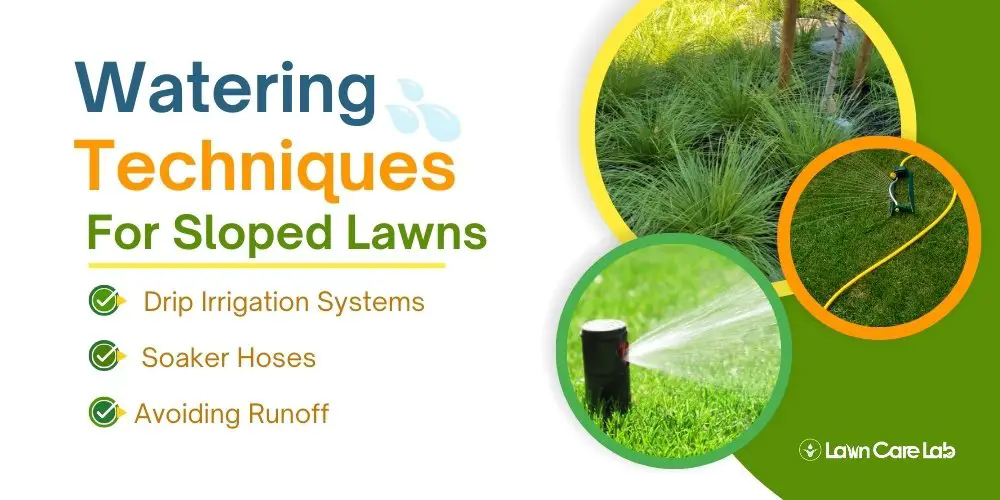
To efficiently water your sloped lawn, use drip irrigation systems or soaker hoses, which ensure even water distribution and reduce runoff.
Watering slowly and in intervals allows the soil to absorb water effectively, preventing erosion and keeping your lawn healthy without wasting water.
Efficient Watering Methods
1. Drip Irrigation Systems
- Deliver water directly to roots, minimizing runoff and water waste.
- Benefits include less soil erosion, even moisture distribution, and water savings.
- Example: Rain Bird Drip Kit.
2. Soaker Hoses
- Release water slowly and steadily, ensuring deep soil penetration.
- Flexible design follows the slope, promoting even water spread.
- Example: Gilmour Soaker Hose.
3. Avoiding Runoff
- Managing runoff on sloped lawns requires careful watering techniques to ensure the soil absorbs water gradually. Water your lawn in short, frequent sessions instead of long periods to enhance soil absorption, reducing runoff and preventing erosion.
- Adding mulches and ground covers can slow water flow and improve absorption.
- Additionally, creating terraces or retaining walls can create level areas that hold water, further minimizing runoff.
Using these techniques will save water, reduce erosion, and keep your sloped lawn healthy and well-watered.
Mowing Sloped Lawns Safely
To safely mow a sloped lawn, use the right equipment and follow specific practices. Choose a lawnmower designed for slopes, such as a self-propelled or ride-on model, and mow side-to-side rather than up and down for better stability. Ensure the mower blades are sharp and only mow when the grass is dry to avoid slipping.
Selecting the right equipment is crucial. A self-propelled lawnmower reduces effort and improves control on slopes, while a hover mower is ideal for very steep lawns due to its maneuverability. Opt for mowers with wide wheelbases and low centers of gravity for enhanced stability.
Adopt safe mowing practices: mow across the slope rather than up and down to reduce the risk of slipping, keep blades sharp because dull blades require more effort and can damage the grass, always mow when the grass is dry to avoid slipping, wear shoes with good traction, and take regular breaks to maintain focus and prevent accidents.
Choosing Appropriate Plants for Sloped Lawns
When picking plants for a sloped lawn, opt for those with deep roots, such as certain grasses, shrubs, and perennials, to stabilize the soil and prevent erosion.
Select species that suit your local climate and soil type for optimal growth and minimal care.
Deep-Rooted Grasses
Deep-rooted grasses like tall fescue, Bermuda grass, and buffalo grass are ideal for stabilizing slopes and preventing soil erosion. These grasses have robust root systems that hold the soil together, improve its quality, and adapt well to different soil conditions. They are drought-tolerant and require minimal maintenance, making them perfect for challenging terrains.
For the best choice for your sloped lawn, consider:
- Tall Fescue: Suitable for cooler climates, with deep roots that stabilize soil.
- Bermuda Grass: Ideal for warmer areas, known for strong growth and resilience.
- Buffalo Grass: Low maintenance and drought-resistant, perfect for eco-friendly lawns.
Using these grasses will help you maintain a lush, functional, and safe sloped lawn.
Shrubs and Perennials
Incorporating shrubs and perennials on a sloped lawn adds stability and visual interest year-round.
Shrubs like juniper, rosemary, and cotoneaster have deep roots that reduce erosion, while perennials such as daylilies, hostas, and ornamental grasses add color and texture.
These plants are low maintenance and adapt well to various conditions, making them ideal for slopes.
Enhancing Aesthetic Appeal
To enhance the aesthetic appeal of your sloped lawn, utilize terracing and layering techniques to create flat areas and add visual interest with varying plant heights.
Incorporate hardscape elements like pathways, steps, and retaining walls for both beauty and functionality.
Terracing and Layering
Terracing and layering transform a sloped lawn by addressing soil erosion and water management while creating an attractive landscape.
Here are some tips:
- Terracing: Build terraces to create flat spaces for planting or sitting.
- Layering: Use a mix of ground covers, shrubs, and taller plants for a varied look.
- Water Management: Make sure terraces direct water flow to prevent erosion.
These techniques will help you create a beautiful and functional sloped lawn.
Incorporating Hardscape Elements
Adding hardscape elements like pathways, steps, and retaining walls can make your sloped lawn both beautiful and functional. Pathways and steps make it easy to walk across different levels, reducing the risk of slipping.
Retaining walls help create terraces, which prevent soil erosion and manage water flow. These terraces also provide flat areas for planting.
You can also add seating areas and water features for more visual appeal and relaxation spots. Garden art can be used as focal points to enhance the overall design. By planning and installing these elements carefully, you’ll create a landscape that’s easy to maintain, safe, and enjoyable for everyone.
For example, consider using stone or brick for pathways and steps, as they’re durable and slip-resistant. Retaining walls can be made from materials like concrete blocks or natural stone to blend seamlessly with the environment.
Adding a small fountain or pond can create a peaceful atmosphere, while a bench or set of chairs can offer a place to sit and enjoy the view. Garden statues or sculptures can serve as interesting focal points.
Regular Maintenance Tips
To keep your sloped lawn in good shape, follow a seasonal care guide with tasks for each time of year.
Check the soil regularly to ensure it drains well and is fertile, which helps stop erosion and weeds.
These steps will help keep your lawn healthy and strong.
Seasonal Care Guide
A seasonal care guide is essential for keeping your sloped lawn healthy and attractive throughout the year.
Here’s a simple breakdown of what to do each season:
Spring:
In the spring, it’s important to aerate the soil to improve air and water flow. Next, overseed to fill in bare spots and apply fertilizer to encourage new growth. This sets a strong foundation for the rest of the year.
Summer:
During the summer months, focus on regular watering to keep the lawn hydrated, especially during hot, dry spells. Mow consistently to keep the grass at an optimal height, which helps it stay strong and healthy.
Fall:
In the fall, rake leaves to prevent them from smothering your grass. Apply a final round of fertilizer to give the lawn the nutrients it needs to withstand the winter. Also, take steps to prepare your lawn for the cold months ahead.
Winter:
In winter, keep your lawn free of debris, like fallen branches and leaves. Monitor for any signs of disease or damage so you can address issues promptly.
Monitoring Soil Health
Regularly testing your soil’s pH and nutrient levels ensures your lawn gets the right care. Knowing your soil’s condition helps you decide on the best fertilization and amendments.
Adding organic matter like compost improves soil structure and fertility. Proper drainage is key to avoiding waterlogging and soil erosion, especially on sloped lawns.
Keep an eye on your soil’s health and make adjustments as needed. This attention encourages strong root growth and a healthy, green lawn. Good soil care not only makes your lawn look nice but also keeps it safe and long-lasting.
Conclusion
Maintaining a sloped lawn requires specialized techniques to address unique challenges such as soil erosion, water runoff, and safe mowing practices.
By selecting the right plants, implementing proper watering methods, and enhancing the landscape with terracing and hardscape elements, you can create a beautiful, functional, and stable lawn.
Regular maintenance and monitoring of soil health are crucial to ensuring your sloped lawn remains lush and resilient year-round.
With these strategies, your sloped lawn can thrive, providing aesthetic appeal and environmental benefits.
Frequently Asked Questions
How Can I Install a Retaining Wall on a Sloped Lawn?
What Types of Ground Cover Are Best for Steep Slopes?
Are There Any Specific Tools Needed for Maintaining a Sloped Lawn?
How Can I Prevent Weed Growth on a Sloped Lawn?
Can I Create a Vegetable Garden on a Sloped Lawn?
- How to Create a Lawn Care Schedule for Southern Climates - October 30, 2024
- How to Use Compost Tea to Boost Lawn Growth and Soil Health - October 23, 2024
- The Best Grasses for Saltwater-Exposed Lawns: Coastal Lawn Care - October 17, 2024

